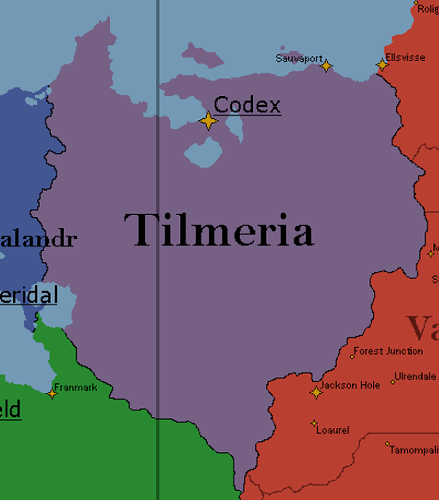THIS IS A JOINT CLAIM BETWEEN NORGS, LUNA, AND TUVAAAAAAAAAAAA
Flag:
Nation Name (long): The United Secular Republics of Tilmeria
Nation Name (short): Tilmeria
Motto: For the Sisterhood, For Sauvageon, For Liberty.
National Animal: Tilmerian Bison
National Flower/Plant: Vangji Fruit
National Anthem: March of the Tilmerian Warrior
Capitol: Codex
Largest City: Codex
Demonym: Tilmerian
Language: Codexian, Nys’tat’en, Frakanic, Ngodian
Species:
- 28% Kelf
- 25.5% Elf
- 18% Ulvrikian Elves
- 5.2% Kromma Elves
- 1.3% Z’rei Elf
- 1% Other
- 15% Human
- 13% Kemonomimi
- 3.5% Orc
- 5.5% Other
Population: 56,115,646 (2023 Estimate)
Government type: Federal Presidential-Parliamentary Republic
Leader(s): J. J. Northern
Legislature: Bicameral Parliament, split between the Council of Governors and the House of Representatives
Formation: 1969 as the United Secular Republic
Total GDP: $1,050,000,000,000
GDP per capita: $18,737
Currency: Tilmerian Kroner (pegged to the Standard Hawking Dollar)
Calling Code: +769
ISO 3166 code: TIL or TLM
Internet TLD: .tlm
Historical Summary: During the collapse of the Ulvrikian Empire, the lands of modern day Tilmeria remained disunited into different Jarldoms and Provinces. With the lands becoming easily swallowed by regional powers such as the Kingdom of Atlalandr in the west and the Jarldom of Rødhøyde from the East during the 1200s. With lands becoming a border land in between West and East Ulvrikians. With different kings and Queens competing over the different local leaders for their military prowess.
It was not until 1782 that the lands of Tilmeria would become free of foreign rule, when Sauvageon of the Queendom of Lapérouse established a military foothold during the Sauvageon Wars in what would become the city of Codex. By 1796, the area was organized under a Quén-duchy, which remained relatively stable for about a century, experiencing the Concordian Industrial Revolution in tandem with the rest of the continent. As the 18th century turned to the 19th, South Hills inserted its own loyal government officials under the Quén-duchy, including Idelle the Crossbred, a denounced member of the Frida Dynasty. As well an inquiry about the duchess having an extramarital affair with a human Concordian industrialist. The trial was mostly a sham, as Idelle was sickly for quite some time the alleged affairs. The Quén-duchy’s loyalty to South Hills made Atlalandr unable to reinforce its claims on its past territories.
Despite the nation’s large economic growth as a result of rapid industrialisation through continued investments from Concordian corporations into the country, it led to rapid economic inequality with Tilmeria’s new business classes benefiting from industrialization. Leading to large labor protests demanding fairer pay and protections, with said demands being continuously ignored. On the 5th November 1902, the Tilmerian Army harshly repressed the protesters, the day becoming nicknamed the Bloody November. Leading to a series of Einarist groups organizing militia groups against the government starting a full uprising against the government on the 1st December 1902. The Einarist revolutionaries had minor successes during the first years of the civil war, with many soldiers deserting to the Einarist side. Despite the advantage of morale and manpower, Einarists failed in capturing Codex and Sauvaport, with the government’s army being well equipped through material and financial support from UCCS. Leading to the civil war bugging down, devastating the country. It was not until the revolutionaries capture of Codex on the 10th November 1915, that the Civil War officially ended. With the government and many of Tilmeria’s wealthy fleeing the new Revolutionary Einarist government, with them leaving by ship from the port city of Sauvaport with the UCCS navy protecting their escape. With the revolutionaries forming the Socialist Union of Tilmeria, forming a Revolutionary Einarist government. With the Revolutionary Council proclaiming victory against “Concordian Capitalism and Influence”. The Revolutionary Government was however a short-lived one as in 1917 the Concordian and Atlalandian Governments jointly organized a military invasion of Tilmeria, with the east part of the country being given back to the old government. With the west being annexed by Atlalandr once more.
The loss of Tilmeria’s western lands to Atlalandr became a major point of contention within the nation’s politics, with the Duchess and her government becoming increasingly seen as illegitimate by the Tilmerian people at large. With the Tilmerian economy becoming also increasingly on the decline as the nation hit the 1930s as the Concordian government focused continuously more inwards. With the government increasingly failing to recover from the civil war and partition, radical beliefs were soon to emerge by the 1940s but ones that would come from the right. With a political organization called the National Front for Equality (NFE) emerging in popularity in spite of government censorship. With the group being founded by mostly male veterans of the Civil War, opposing the largely matriarchal Hjørdist system governance while expressing a specifically Nationalistic and Secularist ideology of Monteideism, one named after the town of Monte Ide where the group was founded. The ideology was made by Berg Lamortar, who was inspired by Hirdism and Einarism yet found both beliefs to be too radical. Expressing that Monteideism would take the lessons of Hirdism and Einarism but moderating them to “commonsense values”. Despite the NFE’s popularity it was not until the 1950s that the movement found larger success as the UCCS government ended up in a Cold War against the Norgsveltian and Vistari government. With the purple scare in the UCCS worsening the relationship between them and the Quén-duchy. In a shocking move the Duchess Idelle VI announced on the 10th August 1959 that her government’s position was to distance itself from the UCCS and become a neutral nation in the Cold War. With Tilmeria opening diplomatic relations with Atlalandr once more. The decision was met with harsh criticism from the Concordian government, with President Schmidt quickly ordering the ISSH to organize a coup against the Duchess and her government. With the Concordian Intelligence Service getting in contact with army officers and the NFE to organize a coup against their monarchy.
On the 5th December the 1959 Tilmerian coup d’état started, with the NFE marching on the capital with the military coup officers arresting several members of the government. With Idelle VI and her family fleeing across the border with Atlalandr, going into exile until moving to Norgsveldet later on. An presidential republic under a one party state was established, with Berg Lamortar becoming the country’s first Senior Governor of the Secular Republic of Tilmeria. One of the first acts the government enacted was the nationalization of major industries and establishment of a planned economy. With President Schmidt and Senior Governor Lamortar signing a treaty officalising the Ellsvisse Accords (EA), an military alliance between the two and giving the UCCS clear access to Tilmerian territory. Including a secret agreement in which the Tilmerian government will be obliged to help fund the UCCS’s nuclear program. With Tilmeria’s border with Atlalandr being quickly militarized as the former increased its rhetoric to take back Tilmeria’s western lands. With the Norgsveltian and Vistari nuclear weapon tests the next year successfully detering Tilmerian and UCCS governments to act on the rhetoric. With the Tilmerian government doing large scale purges against anyone considered to have royalist sympathies. With it being estimated that between 10,000 to 40,000 people across the country were being executed for having royalist sympathies. Despite being largely popular among ethnic Tilmerian population, especially among men, it faced heavy opposition by the Hjørdist Temple and religious minorities opposing the secular and nationalist policies of the government. With the government banning the Nys’tat’en and Ngodian languages, much to the anger of the Akuan and Duarist minorities.
Relations improved between Atlalandr and Tilmeria after the former abolished the monarchy, with Atlalandian President, Bjørn Lotir, meeting up with Senior Governor Lamortar and Concordian President, Frederick Schmidt, meeting up in the Tilmerian capital of Codex. With Bjørn Lotir opened up for territorial negotiations to work out a border settlement. Though the efforts were cut short by the start of the Violet Restoration War, also known as the Atlalandian Civil War, as Norgsveltian backed Royalists in Western Atlalandr rose up in opposition to the Republican government in 1966. With the war becoming a stalemate as the conflict turned into a vicious proxy war between a Norgsveltian/Vistari led coalition in support of the Royalist rebels against the EA backed Republican government. With the republicans pushed to the most eastern parts of Atlalandr, ending the war in a ceasefire in 1968. With the Tilmerian government taking advantage of the Republicans dependency on the EA to annex back its western lands the same year. Even with the establishment of an Einarist One Party state in East Atlalandr in 1971, Secretary General Veri Våld announced it would not oppose the annexation. With East Atlalandr being fermently dependent on EA’s security and military protection.
The annexation was a large public boost for the Tilmerian government, giving it a large amount of resource rich lands. Despite the popularity for the government, economic stagnation in the 90s increased political opposition to the government with large political protests pushing for democratic reforms increased in amount. With the death of Senior General Berg Lamortar in 1998, leading to reformist Elizar Lierre taking over. The country became a federal parliamentary republic in 2001, with its first parliamentary election held in 2002. With it being established as the United Secular Republics of Tilmeria. Despite nominally democratic reforms Lierre was successful in ensuring the NFE’s successor party, the National Tilmeria Party (NTP) had largest control of the country’s institutions and close partnership with the religious conservative Hjørdist Democratic Party (HDP).

